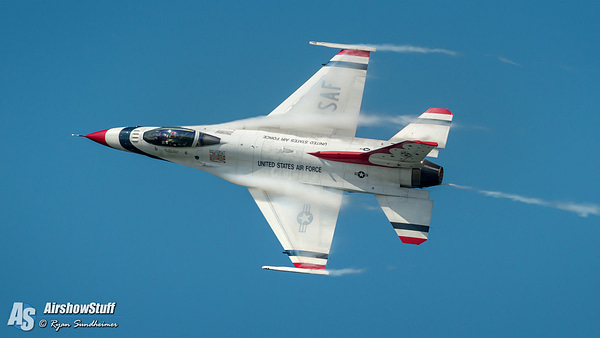The US Air Force has released the crash investigation report for April’s fatal crash of Thunderbird #4, Maj. Stephen “Cajun” Del Bagno. Cajun was flying a practice routine with the team near Creech AFB in Nevada when his aircraft impacted the ground.
Very little information about the crash has been made public until now, and the remote location ensured there were few if any civilian witnesses. The report does not hold back, however, and describes in great detail how Del Bagno tragically succumbed to G-induced loss of consciousness, or G-LOC, during a high speed dive and failed to recover from it.
Specifically, the dive was part of the rejoin maneuver following the High Bomb Burst and four-ship crossover. Following the cross, the #4 pilot pulls up into a half loop, then flies down the show line inverted before pulling downward into a Split-S to drop into formation behind the lead aircraft. You can watch a video of the typical #4 rejoin sequence on our Youtube channel.
The report explains that on this particular occasion, Del Bagno flew at a maximum of -2.06 Gs while inverted, before immediately pulling to a peak of 8.56 Gs. It is believed that this quick transition from strong negative to intense positive Gs was too much for even the seasoned fighter pilot to handle. He lost consciousness for an estimated 5 seconds as the aircraft rocketed towards the ground. No attempt at ejection was registered by the aircraft systems and the aircraft impacted at nearly 60 degrees nose down and 90 degrees of bank with a descent rate of near 40,000 feet per minute.
Blue Angel #6, Capt. Jeff “Kooch” Kuss, was also killed while performing a Split-S about two years before Cajun’s accident. In that case, it was determined that he mistakenly initiated the maneuver lower than required. Following his crash, the Blue Angels removed the Split-S from their takeoff routine, although they do perform the maneuver later in the show.
As for the Thunderbirds, they resumed flying a few weeks after the crash, eventually bringing back former #4 pilot Major Nick “Khan” Krajicek to assume the slot position again. Based on observations at shows following the crash, they do not appear to have significantly changed the rejoin maneuver.
Here is the executive summary of the full 37 page report:
On 4 April 2018, the mishap pilot (MP), flying a F-16CM, tail number (T/N) 91-0413, assigned to the United States Air Force Air Demonstration Squadron, the “Thunderbirds,” 57th Wing, Nellis Air Force Base (AFB), Nevada (NV), engaged in a routine aerial demonstration training flight at the Nevada Test and Training Range (NTTR) near Creech AFB, NV. During the training flight, at approximately 1029 local time, the mishap aircraft (MA) impacted the ground and fatally injured the MP, without an ejection attempt.
The mishap mission was planned and authorized as a practice of a Thunderbirds aerial demonstration in the south part of the NTTR. The mishap flight was a formation of six F-16CMs (Thunderbirds #1-6), the standard Thunderbirds aerial demonstration flight. Thunderbird #4 was the MA/MP. During the High Bomb Burst Rejoin, an aerial maneuver near the scheduled end of the aerial demonstration training flight, the MP flew the MA for approximately 22 seconds in inverted flight between 5,500 and 5,700 feet above ground level. During this time, the MP experienced a change in force due to acceleration measured in multiples of the acceleration of gravity felt at the earth’s surface (G), between -0.5 to -2.06 G’s. While experiencing -2.06 G’s in inverted flight, the MP initiated a descending half-loop maneuver (Split-S). After five seconds in the Split-S, the MP attained a maximum +8.56 G’s. The MP experienced G-induced loss of consciousness (G-LOC) and absolute incapacitation at the end of that five-second period.
For approximately the next five seconds, the MP remained in a state of absolute incapacitation and made no deliberate flight control inputs as the MA accelerated toward the ground. Approximately one second prior to ground impact, the MP began deliberate flight control inputs as he transitioned from absolute to relative incapacitation. The MA impacted the ground at 57 degrees nose low with 89 degrees of left bank and the MP was fatally injured on impact, without an ejection attempt.
The Accident Investigation Board (AIB) President found by a preponderance of evidence the cause of the mishap was the MP’s G-LOC during the Split-S portion of the High Bomb Burst Rejoin maneuver. Additionally, the AIB President found by a preponderance of evidence two factors substantially contributed to the mishap: (a) the MP’s diminished tolerance to +G’s induced by the physiology of the MP’s exposure to –G’s (“Push-Pull Effect”) and (b) an associated decrease in the effectiveness of the MP’s Anti-G straining maneuver under those conditions.




Tara Chipman
I have a lot of respect and admiration for number 4 . I have a special place in my heart for an act of kindness that I hope to one day return.